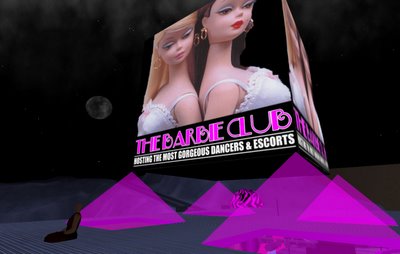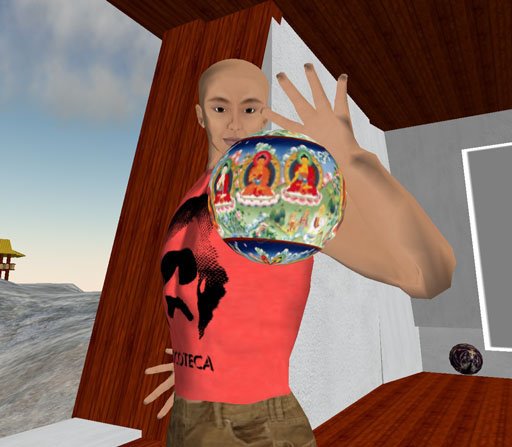One Tibetan Hermitage, Strip Club Attached
 [above, Tenzin inspects the roof of neighbouring Barbie Club, a popular escort club and strip joint in Second Life]
[above, Tenzin inspects the roof of neighbouring Barbie Club, a popular escort club and strip joint in Second Life]Our world is rife with unusual confluence and connection. At this very moment in Tibet, for example, one of the greatest temples of yogic instruction, the Lukhang, sits quietly a go-kart track and amusement park, just around the corner from the Potala Palace. And in Second Life, one of the metaverse's busiest escort services sits next to the Tibetan power place of Terdrom, a site inspired after the real-life hotsprings and nunnery north of Lhasa.
Well, it had to happen sometime. Hookers and monks are neighbours. [update: sadly, this temple location was moved back to Drak Yerpa in Zoe; conditions in the sim, extreme lag for example created by strippers, escorts and customers made it nearly impossible to operate a site in that location]
In RL, Terdrom is a remote mountain enclave about a half-day drive north of Lhasa. Its natural hotsprings -- mineral springs that magically bubble from a gravel riverbed -- go back to the 8th century, the early days of Buddhism in Tibet, when the great Indian teacher, Guru Rinpoche, tamed local demons and gifted the hotsprings to aspiring pilgrims, monks and nuns, "promising that their waters would cure every ailment of the body."
Back in SL, you get the Barbie Club thrown in for free. Perched above the waterfront hermitage in Refugio, patrons and working girls occasionally wander down to Terdrom's snowy waterfront and wonder at it all. Tibetan teachings and chanting on the audio stream do nothing if not confuse a freshly-serviced john who's tumbled down the steep hill and into Terdrom's purification waters.
 [above, lotus meditation at Terdrom, in the shadow of Barbie]
[above, lotus meditation at Terdrom, in the shadow of Barbie]More than a few people have wondered, why bother with Buddhism in Second Life? After all, malls, casinos and nightclubs do dominate the landscape -- hardly sacred terrain. But this confluence of desire, consciousness and imagination seems almost too perfect to ignore.
All those little green dots on the Second Life map, each represents a singular consciousness. We're all flying about, not too unlike the arhats, adepts and bodhisattvas depicted in so many ancient Buddhist paintings, all highly-realized beings who can fly, withstand cold, not require sleep or food and/or conjure spells and various magical objects at will. (All mundane powers in the face of enlightenment, which is the supreme accomplishment, as traditional texts note.)
Even with all its griefers and kink, Second Life might well embody core Buddhist teachings about how consciousness is not singular, that avatars are as real a phenomenon of one's mind as anything else. Each green dot on the SL world map is a bundle of memories, aspirations, desires, an emanation of our real-life selves. Put another way, Second Lifers are often surprised at how much of their real-life (RL) selves winds up out there on the grid, making friends, enemies, lovers, cyber-sexing, building, destroying, exploring, searching. This kind of extension of self into virtual worlds -- sometimes profoundly invested in virtual life, if the emotion on display in SL's discussion forums is any indication -- poses questions, not so much about the melding of machine and mind, but about our waking assumptions about identity and everyday existence.
Do Second Life's avatars and sims pose some kind of new mental yoga that might help to broaden and dissolve assumed truths about real life? Tantric adepts and siddahs from the 4th century onward have tried to break down innate, mundane ideas about reality and consciousness, all in an effort to fully realize our inherent potential.
Put yet another way, is playing Second Life a subtle,unfocusedd form of meditation? Can the very architecture of advanced on-line gaming potentially benefit its denizens, simply by allowing people to dissolve themselves into on-line worlds?
I have no idea how to begin answering these questions. But I do recall a favourite quote from the late Kalu Rinpoche, a great lama from Eastern Tibet who spent his last days teaching and founding dharma centres in the West:
"It is quite truly said in the Vajrayana tradition that the deeper the dharma, the deeper the negativity that we encounter in our practice." [from The Foundations of Tibetan Buddhism, Snow Lion Press]
Spiritual progress can be a messy business; anyone who says otherwise is probably selling you something. Again, it all comes back to some of the unlikely connections found within the landscape of Second Life's metaverse: strippers and griefers and other denizens of SL's sketchier realms are not only fellow travelerss, but emissaries from our own consciousness, the darker corners of mind that nevertheless possess great energy and potential for realization. The tantric path, the Vajrayana, is filled with images of demons, sexual consort, wrathful Buddhas and such. Second Life often gets a bad rap for distilling essential and sometimes flawed human energies -- and in-world Buddhists sometimes get hassled for being there -- but it is probably as real and accessible a version of un-edited, unvarnished mind as one can find online. In other words, SL is like a mandala -- a three-dimensional otherwordly abode -- not for deities or buddhas, but for our inherent buddhanature, as obscured as it may be at times.
So we build temples within this landscape to celebrate and remind ourselves of said potential, just as generations past explored uncharted terrain in RL, and we see what happens next...


1 Comments:
Tenzin -- you've clearly given the similiarities and connections between RL and SL some thought, and I like the points you've made. While it's only happened to me once, I have seen and talked to the person who stumbles down the hill and wanders into the hall beneath the stupa beside the hot spring. It wasn't a pleasant experience per se, but I think we both learned a lot. His point was to question everything (specifically, why would I take my shoes off to sit before an image of Buddha) while mine was that there's a little bit of good in every single being.
Thanks for making these points.
-Nate
Post a Comment
<< Home